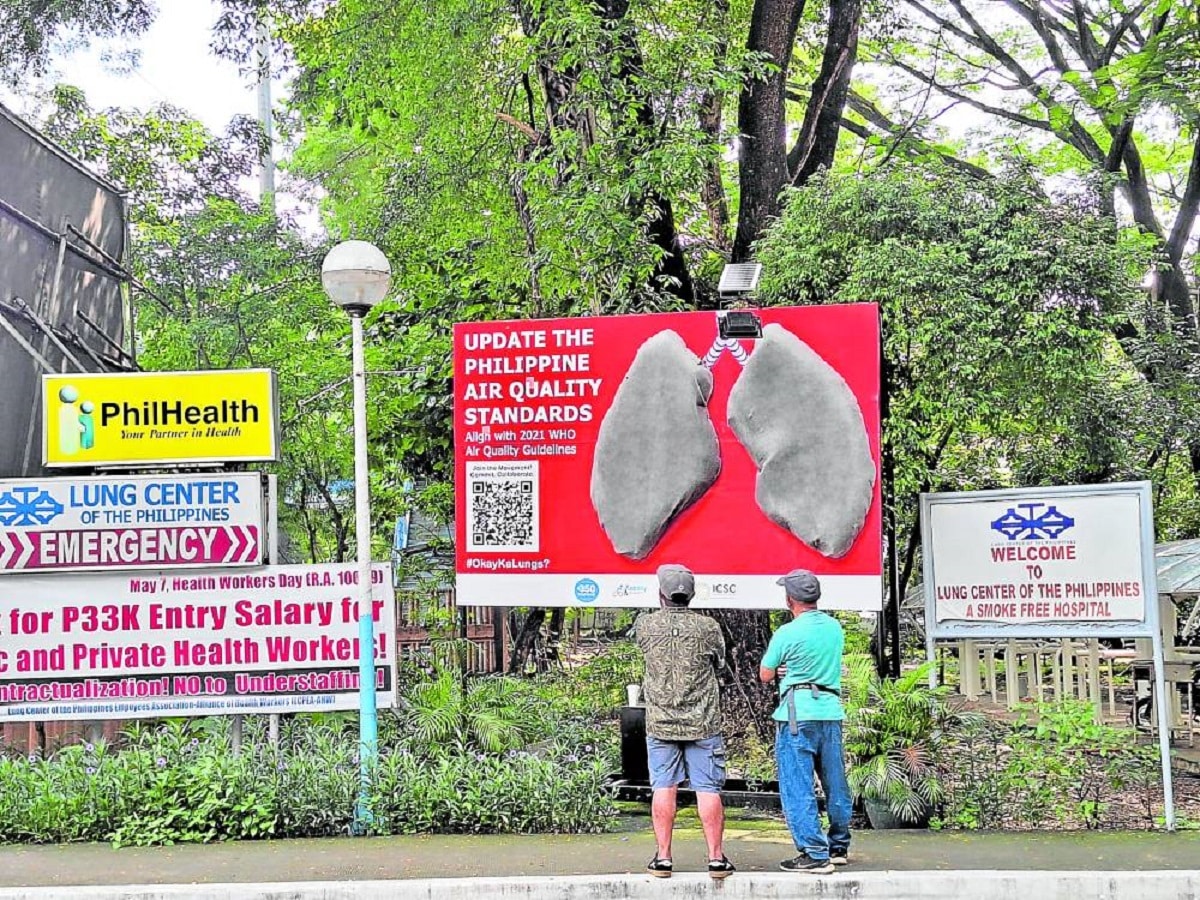
GRAY AREA The “lungs” in this “Breathing Billboard” outside a government specialty hospital in Quezon City were pure white when installed on Aug. 2 and looked like this when taken down on Aug. 21—a worrying sight for clean air advocates. —LEO M. SABANGAN II
Clean air advocates are calling for an update of the country’s air quality standards to make them “as close as possible” to the safety parameters set by the World Health Organization (WHO).
Their campaign, launched in line with the observance of National Lung Month in August, came with the installation of the “Breathing Billboard,” a monitoring system set up outside the Lung Center of the Philippines in Quezon City that was designed to help the public visualize the level of air pollution in Metro Manila.
READ: Metro Manila air quality remains ‘good to fair’ – DENR
The lung-shaped contraption, which was used for 20 days, was fitted with high-efficiency particulate air filters and a fan that made it mimic the movements of human breathing.
From being pure white when it was put up on Aug. 2, the installation had turned dark grey when dismantled on Aug. 21—suggesting the gravity of the problem that the advocates wanted to be addressed.
The project was organized by 350 Pilipinas and the Institute for Climate and Sustainable Cities (ICSC), on behalf of their Mobility Awards coconveners (The Climate Reality Project Philippines, Pinay Bike Commuter Community and MNL Moves), and Health Care Without Harm Southeast Asia, in collaboration with different groups campaigning for clean air in the country.
International campaign
The installation was conceptualized by the India-based Jhatkaa.org as a way of demonstrating the importance of clean air to human health. It was first set up in Bangalore and later in two other cities in Delhi, India, in 2018, before being adopted by different campaigners in Poland, Romania, London and Serbia.
Air pollution remains a major public health problem that also translates into heavy economic losses, according to ICSC partnerships and advocacy adviser Francis Joseph dela Cruz.
Despite the enactment of the Clean Air Act in 1999, the Philippine National Ambient Air Quality Guideline Values remain significantly higher than the WHO guidelines, which were updated in 2021.
“We have to act urgently in updating the Philippine air quality standards as close as possible to WHO safety levels,” Dela Cruz said.
He called on the Department of Health and the Department of Environment and Natural Resources (DENR) to extend “further participation and support to ensure the protection of Filipinos from the harmful impacts of air pollution.”
“Clean air is no longer just an environmental concern. Poor air quality is depriving us of one of the key ingredients to a healthy, maximally productive life. We need to protect the air to protect our health,” said Dr. Miriam Lalas, head of the Air Pollution and Climate Change Subcommittee of the Philippine College of Chest Physicians.
According to the DENR, the country’s current 24-hour “acceptable” threshold or guideline value for PM10—a technical term for microscopic matter suspended in the air—is 150 micrograms per normal cubic meters (ug/ncm), while the annual guideline value is 60 ug/ncm.
In urban environments, PM10 generally takes the form of dust from paved and unpaved roadways, which can enter the human body through the nose and throat and also irritate the eyes.
Both Philippine guideline values are higher compared to the WHO recommendations as of 2021—20 ug/ncm and 50 ug/ncm for annual and 24-hour averaging times, respectively.
The Breathing Billboard installation is part of a series of activities commemorating the 25th year since the passage of the Clean Air Act.
According to the WHO, about seven million people die worldwide each year due to health problems traced to air pollution.